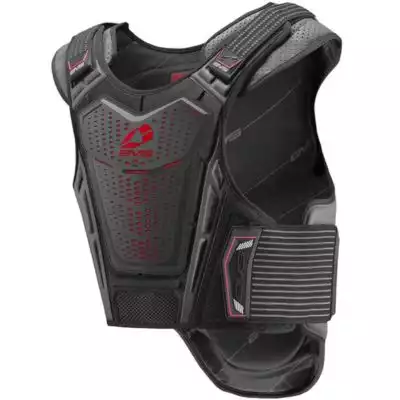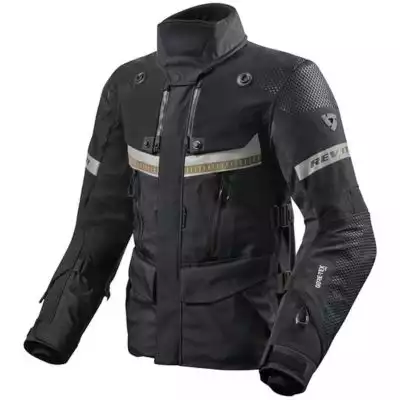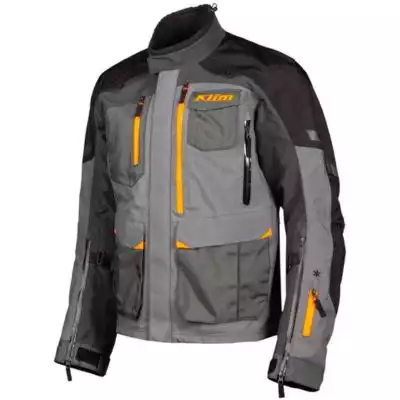Choosing a motorcycle jacket can be tricky, though, since there are so many to choose from. The many different styles, materials, and features can turn your side quest of finding a new jacket into the whole game.
So that you can focus on leveling up your riding, we’ve put together this ultimate motorcycle jacket buyer’s guide.
Trust me, a biker jacket is far more than just a fashion statement!
Safety
A motorcycle jacket’s main job is to protect you. It does this in two ways:
- Protects against impacts
- Offers resistance against abrasion.
Anything else a jacket can offer after its protective properties is a bonus.
Impact Protection
A good jacket should be equipped with quality protective armor and padding to protect you in an impact. Any impact on a motorcycle, even at slow speeds, can be traumatic for the body, resulting in serious injury.
Look for armor at the elbows, shoulders, and back — at a minimum. Some jackets even offer chest protection. As a general rule, the more armor, the better, but this does come at an increased cost.
Motorcycle armor is constructed from various materials, including memory foam, silicon, plastic, and viscoelastic, or a combination of them all.
D30 armor is one of the most popular choices for motorcycle armor, it is a polymer-type substance. It molds to the body as it heats up, staying soft and supple as you ride, but on impact, it hardens up to absorb the energy. The Icon Contra 2 Jacket is an example of a jacket using D30 armor.
You’ll often find soft armor on the inside and hard armor on the exterior of the jacket, particularly with sports jackets, which can have internal soft memory foam pads and external TPU (thermoplastic polyurethane) armor for added durability in a slide.
Unfortunately, I see many jackets without a back protector or equipped with just a simple foam pad, which does little more than keep the shape of the jacket.
Be sure the jacket is equipped with actual protective armor, and if it’s not, make sure you pick up a quality back protector at the same time you buy the jacket.
If your jacket doesn’t have a back protector pocket, I would recommend picking up an armored underlayer shirt or individual back protector, such as the EVS Sports Vest.
CE Ratings
Motorcycle armor has a CE rating of either Level 1 or Level 2. However, motorcycle armor in the US is not required to meet CE standards unless you are racing on a competitive racetrack.
If armor is CE-rated, it means it meets the mandatory motorcycle equipment safety standards required in Europe. However, knowing that your armor has been tested and certified to meet minimum standards as opposed to no standards is why riders across the country still prefer CE-rated armor as an option.
CE Level 1 applies to armor that transmits a maximum force of 18kN in an impact.
CE Level 2 armor only allows transmission of a maximum force of 9kN.
CE Level 2 is, therefore, the most protective option. The only other thing to keep an eye out for is the wording on the CE label:
- CE-tested armor means the manufacturer has tested the armor in-house to CE standards and states it meets or exceeds the requirements.
- CE-certified armor means a sample of the armor was tested in a CE testing facility.
- CE-approved armor means that most or all of the product’s parts were tested in a certified facility and achieved CE accreditation.
Ratings are not the be-all and end-all of how safe a jacket is, but they do give you something to work with, especially as a new rider when the whole process can be confusing.
Material: Leather vs Textile
While you can usually upgrade your jacket’s protective armor to improve how well it performs in an impact, the material of the jacket cannot be changed, and that is mostly what dictates how good it is at protecting you from abrasion.
One of the biggest recent debates has been whether leather or textile offers the best protection, specifically in relation to abrasion resistance. The debate is about more than just how protective a jacket is, but also how practical it is to meet your needs and riding style.
Leather has long been considered the most protective material for a motorcycle jacket. Only leather can be worn on the track for this reason. You will not see a professional racer in a textile two-piece.
However, leather has its downsides. It’s heavy, not waterproof, often uncomfortable, and hot in the summer.
Meanwhile, textile jackets — Cordura, for example — are now of extremely high quality, considered to be very durable, if not more durable than some leather options, and have the benefit of being more versatile.
As a result, there’s been a surge in Cordura-type jackets, as well as jackets lined with Aramid fibers and Kevlar, and even traditional flannel shirts are now considered to be usable as a riding jacket.
Featuring various layers, textile jackets can be built for winter, summer, or all-year riding. They can be waterproof or have mesh inserts for maximum ventilation. They are also usually more adjustable.
The difference between leather jackets and textile jackets has slowly begun to shrink as manufacturers are putting the same features typically found in a textile jacket into a leather one, such as removable waterproof/thermal liners.
The truth is there are pros and cons to both materials, and it will come down to personal choice, but from a protection perspective, you just want to make sure you pick a durable jacket that will serve its main true purpose — to protect you.
Be sure to look for double/triple stitching and reinforced areas at the impact zones, and make sure any stretch/mesh panels are correctly stitched so there is no weak area. All these things will help make sure you buy a durable jacket regardless of material.
Extra Protection
The latest technology for motorcycle jackets is a jacket that comes equipped with or can be fitted with an airbag system.
Read more: Best Airbag Jackets
Some airbag systems are fitted into the jacket, others are made specifically to work with certain jackets only and are an add-on, or you can get airbag vests that are meant to work with any riding jacket.
Without getting too technical, there are several types of airbag systems. Some clip onto the bike, and if you get removed from the bike in a crash, a sensor goes off, and they instantly deploy. Others use AI to sense your body position, speed, etc., and then deploy.
An airbag jacket or airbag system does not come cheap, but it is the latest and most technologically advanced protective system currently available for riders to protect their chest, shoulders, and back.
Type
As with motorcycle helmets, there is an almost endless list of the types of motorcycle jackets on the market. But they all fulfill different riding needs, and each has its own specific purpose.
Once you know the level of protection you want, you can begin to search through the various types of jackets available:
- Summer (Read: Best Summer Motorcycle Jacket)
- Winter (Read: Best Winter Motorcycle Jacket)
- Textile (Read: Best Textile Motorcycle Jacket)
- Mesh
- Leather
- Waterproof
- 4 season
When looking at the types of jackets available, you want to consider your riding needs and ask yourself some essential questions:
- Do I ride all year?
- Will I ride in the rain?
- Are the summers really hot?
- Do I ride at high speeds regularly?
These questions will help you figure out if you need waterproof properties, thermal liners, mesh panels, or a jacket that has it all, such as the REV’IT! Dominator 3 GTX Jacket.
On top of the types of motorcycle jackets available, you also have a range of styles to choose from, including sports, adventure, touring, and casual.
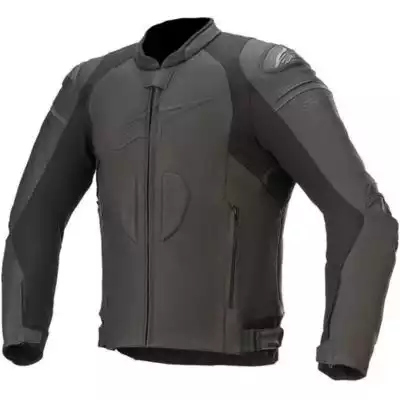 Alpinestars GP Plus R v3 Airflow Jacket
Alpinestars GP Plus R v3 Airflow Jacket
Sports jackets come in both leather and textile. They can be equipped with thermal and waterproof liners for winter riding or be very minimal, with mesh inserts for summer riding.
The Alpinestars GP Plus R v3 Airflow is a leather summer sports jacket, and loaded with armor or pockets for add-on armor, it’s ready for the track or the streets.
Sports jackets tend to be the most protective option with the most armor because they are built for the high-speed riding associated with sports bikes.
There are ordinary sports jackets but also track-focused jackets, which are sports jackets on steroids. They tend to be the most protective, equipped with CE Level 2 armor, connection zippers for matching trousers, and sometimes a speed hump for extra aerodynamics.
- Quality construction and materials
- Usually equipped with CE-rated armor
- External armor, such as shoulder protectors
- Pretty good airflow on track jackets
- Short-cut can leave lower back exposed
- Lack of storage pockets
- Expensive, especially track-orientated jackets
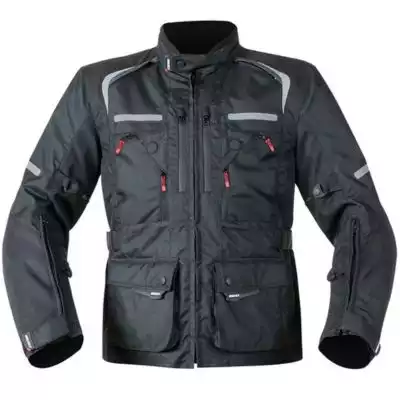 Sedici Avventura Waterproof Jacket
Sedici Avventura Waterproof Jacket
Adventure jackets and touring jackets share many of the same features. They tend to be long, textile jackets, with multiple pockets, waterproofing, removable thermal liners, and lots of ventilation.
These jackets make up most of the four-season jackets since they are versatile for all weather and riding situations.
The Sedici Avventura Waterproof Jacket is a great example. It has a removable quilted thermal liner, removable waterproof liner, and several exterior and interior pockets, along with CE Level 2 armor at the shoulders and elbows with space for an add-on back protector.
Adventure/touring jackets are usually well equipped on the armor front, too, since riding in all weather, but especially the wet, poses its own risks.
- Suitable all-year jackets
- Practical storage with plenty of pockets
- Long-length jackets for maximum coverage
- Fitted with quality CE armor
- Quite bulky with lots of layers
- Mostly textile jackets
- Can lack style
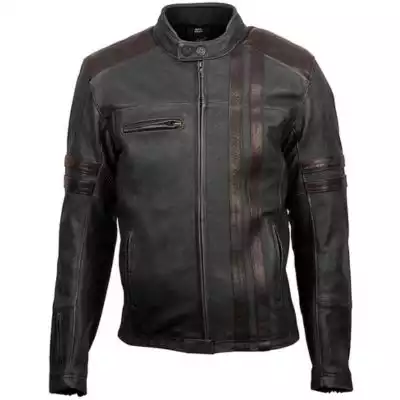 Scorpion 1909 Leather Jacket
Scorpion 1909 Leather Jacket
Casual jackets come in both leather and textile and include armored hoodies and riding shirts.
Read more: Best Armored Hoodie
Read more: Best Riding Shirt
Casual jackets are usually lightweight, suitable for summer riding and slower speeds. You can find Cafe Racer jackets and V-twin jackets on the market that all have a distinct style.
Remember, even if you’re after the perfect leather Marlon Brando-style jacket, you can always upgrade the armor to get better impact protection! What you can’t do is improve the construction or material, so be sure to choose a well-built, durable jacket regardless of the style. A cool protective retro option is the Scorpion EXO 1909 Leather Jacket.
- Stylish
- Comfortable on and off the bike
- Lighter weight than most leather and textile jackets
- Leather ones can be hot due to lack of ventilation
- Hoodies and shirts are arguably less protective than jackets
- Often not the most practical option, i.e., lack of pockets, features
Women’s Jackets
Women’s jackets are available in all the same types and styles as mens jackets. However, they’re cut differently than men’s and are contoured to a female body shape.
Read more: Best Women’s Motorcycle Jacket
Comfort and Fit
A comfortable, well-fitting jacket is key to it being suitable for your needs and lasting a long time. For the ins and outs of how a jacket should fit, check out our post here.
There are a few simple things you can check to make sure you get the right fit:
- Make sure that when you’re in the riding position, the jacket provides full coverage. Be sure the sleeves cover your arms all the way to your gloves and the jacket covers your back.
- Make sure the armor sits in the right place on your shoulders and elbows and the back protector is seated properly.
- Ignore what the size says on the label. Motorcycle clothing is not very accurate when it comes to sizing, so be sure to base your choice on what fits properly.
In terms of comfort there are some key things to note:
- Leather jackets usually need a breaking-in period; they can take a while to soften up and get comfortable.
- Look for neoprene collars and wrist cuffs for added comfort on the neck and wrists.
- If airflow is a priority, look for intake and exhaust vents so cool air can come in and hot air can go out.
- Some thermal liners only cover the trunk of the body as a vest, others are fully sleeved, so if warmth is important, make sure the liner is full-length.
Features
A jacket’s features can aid a rider’s comfort significantly. The main features people look for in a jacket include waterproofing, ventilation, pockets, and layers.
Waterproofing
Some waterproof motorcycle jackets come with removable waterproof liners, which may keep you dry but will also allow water into the jacket and soak the external layer, making your jacket heavier in the rain.
Others have a waterproof membrane laminated to the outer shell of the jacket. The result is that the water doesn’t penetrate the jacket, instead rolling off.
We back Gore-Tex as the best material for waterproofing because it keeps you dry while allowing you to breathe. The Klim Carlsbad Jacket is one awesome example.
Ventilation
The various types of airflow ventilation in motorcycle jackets includes zippered vents at strategic places like the chest and arms, with or without rear exhaust vents. Ventilation can also come in the form of mesh panels inserted into the jacket, usually found in summer jackets.
Mesh jackets are a type of textile jacket that are mostly made of mesh panels formed from tough Cordura-type fabrics. These make excellent summer riding jackets. You can stay protected with armor and abrasion resistance but also stay cool.
Leather jackets tend to be perforated, which is how they let air in and out to cool you down, the perforation is better than nothing but as effective as mesh panels or vents found in textile jackets.
Pockets
Pockets are essential for storing your everyday carry items. Sports jackets tend to have the least storage and adventure jackets tend to have the most.
If you carry a lot, then an adventure/touring jacket is your best bet so you can carry your stuff without bulking out your jacket. Some jackets have an extra cargo pocket in the rear for carrying items like maps.
Liners
Some jackets come with removable liners, including waterproof and thermal liners. These can bulk out a jacket but equally provide a level of functionality that you might appreciate. It all depends on the weather you ride in.
Budget
Motorcycle jackets are available to suit a wide range of budgets, and prices vary widely based on the brand name and features of the jacket.
At the lower end of the budget you will usually find un-certified armor, foam pads in place of an actual back protector, and cheaper materials. At the top end you will find the best quality materials, high-end armor, and available upgrades, like an airbag system.
Without a doubt, you don’t have to spend a fortune to get a protective motorcycle jacket, but you might sacrifice a certain feature or style to save money.
I have an expensive sports-riding jacket for track days, but I also have my mid-range everyday riding jacket that sees me through the rest of the time. Having more than one jacket also helps them last longer.
The chances are, like me, you’ll end up with more than one jacket, and given they’re available at all budgets for all styles, it isn’t the end of the world!
Read more: Best Budget Motorcycle Jacket
